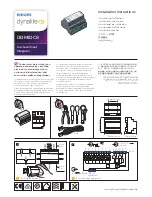
8
Release Notes for Cisco RF Gateway 10 in Cisco IOS Release 12.2SQ
OL-18677-10
New and Changed Information
•
Major system components
–
2 Supervisor card slots (1:1 redundant)
–
2 TCC/DTI card slots (1:1 redundant)
–
10 Universal line card slots (1:N redundant)
–
12 RF switch card slots (Dual-zone redundancy)
–
2 DC PEM slots (1:1 redundant)
–
1 Fan tray module
Cisco RFGW-10 DS-48 Universal EQAM Line Card
The Cisco RFGW-10 DS-48 line card is a 12-port, 48-channel UEQAM card designed to support
Downstream External PHY Interface DOCSIS MPEG Transport (DEPI D-MPT), downstream data
traffic, and video applications (VoD, SDV, and broadcast video). The RFGW-10 DS-48 card is similar to
the traditional QAM solutions where the card receives encapsulated data, depacketizes and reformats the
packets, maps them to the output QAM channel, and performs QAM modulation and frequency
upconversion. From a high level, the DS-48 line card receives video and DOCSIS data encapsulated over
Ethernet and outputs analog QAM data to the subscriber devices (set top box (STB) and DOCSIS
modems).
As a DOCSIS engine, the DS-48 line card supports DEPI D-MPT mode. DEPI is based on the L2TPv3
protocol, which includes a data plane and a control plane. DEPI data plane traffic is terminated at the
line card. The Cisco RFGW-10 Supervisor card terminates DEPI control and communicates the control
to each line card in the system via the chassis IPC infrastructure. DOCSIS timing information (10.24
MHz synchronous DTI clock) is received by the line card from the system TCC cards.
As a video engine, the DS-48 terminates video data path traffic forwarded from the Supervisor card
(video control plane traffic is terminated and processed by the system Supervisor card). The DS-48
processing path classifies video packets, performs inter-QAM processing, bit rate scheduling, program
muxing and scheduling, program identifier (PID) remapping, program clock references (PCR)
restamping, and CC restamping.
The DS-48 line card has 12 physical RF ports, which support up to four QAMs per port. The number of
QAM outputs is configurable on a per-port basis (meaning an individual port can support 1, 2, or 4
QAMs as well as muting of individual QAMs within a QAM group). In stacked QAM mode, the QAMs
are stacked contiguously over a 24-MHz or 32-MHz band. The line card supports a downstream channel
frequency range of 88 MHz to 870 MHz.
Table 4
provides the DOCSIS and EuroDOCSIS downstream rates:
Table 4
DOCSIS and EuroDOCSIS Downstream Data Rates
Downstream
Channel Width,
MHz
Modulation
Scheme,
bit/symbol
Baud Rate,
MSym/sec
Raw Bit Rate,
Mb/sec
Throughput (Bit
Rate - Overhead),
Mb/sec
6
64 QAM (6)
256 QAM (8)
5.056
5.360
30.34
42.88
27
38
8
64 QAM (6)
256 QAM (8)
6.952
6.952
41.71
55.62
37
48









































